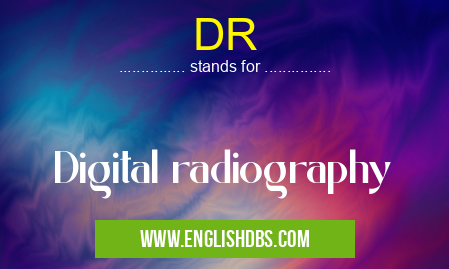What does DR mean in HEALTHCARE
Digital radiography (DR) is advanced imaging technology that utilizes digital detectors to capture and process X-ray images. It is widely used in medical settings for various diagnostic purposes. DR offers significant advantages over traditional film-based radiography, including improved image quality, reduced radiation exposure, and faster processing time.

DR meaning in Healthcare in Medical
DR mostly used in an acronym Healthcare in Category Medical that means Digital radiography
Shorthand: DR,
Full Form: Digital radiography
For more information of "Digital radiography", see the section below.
» Medical » Healthcare
DR Meaning in Medical
In medical terminology, DR stands for digital radiography. It refers to the digital acquisition of X-ray images, replacing the use of film cassettes and processors. The resulting digital images can be viewed, manipulated, and stored electronically.
DR Full Form
- D - Digital
- R - Radiography
How DR Works
DR utilizes digital detectors, known as flat-panel detectors, to convert X-ray photons into electrical signals. These signals are then processed and converted into a digital image. The digital images are displayed on computer monitors and can be stored in digital formats, allowing for easy sharing and archiving.
Advantages of DR
- Improved Image Quality: DR provides sharper, higher-contrast images compared to traditional film-based radiography. This allows for better visualization of anatomical structures, reducing the need for repeat exams.
- Reduced Radiation Exposure: DR systems can utilize lower radiation doses than conventional radiography, reducing patient exposure to ionizing radiation.
- Faster Processing Time: Digital images can be processed and viewed almost instantaneously, eliminating the development time required for film-based radiography. This allows for faster diagnosis and treatment planning.
- Enhanced Diagnostic Capabilities: DR images can be manipulated electronically, such as adjusting contrast and brightness, which enhances the visibility of specific structures.
- Space and Cost Savings: DR eliminates the need for film storage and processing equipment, saving space and reducing operating costs.
Essential Questions and Answers on Digital radiography in "MEDICAL»HEALTHCARE"
What is Digital Radiography (DR)?
Digital radiography (DR) is an advanced imaging technique that uses electronic detectors to convert X-rays into digital images. These images can be viewed, processed, and stored on a computer system, providing numerous advantages over traditional film-based radiography.
How does DR differ from traditional film-based radiography?
DR utilizes electronic detectors instead of film to capture X-rays. These detectors convert the X-rays into digital signals, which are then processed and stored as digital images. Traditional film-based radiography, on the other hand, uses X-ray film to capture the images, which require chemical processing to develop and view.
What are the advantages of DR over film-based radiography?
DR offers several advantages over film-based radiography, including:
- Faster image acquisition and processing
- Improved image quality and clarity
- Reduced radiation exposure
- Enhanced post-processing capabilities
- Digital storage and easy retrieval of images
- Improved efficiency and workflow
What are the applications of DR in the medical field?
DR is widely used in various medical applications, such as:
- General radiography (e.g., chest X-rays, bone imaging)
- Mammography (breast imaging)
- Fluoroscopy (real-time X-ray imaging)
- Dental radiography
- Computed tomography (CT)
Is DR more expensive than traditional film-based radiography?
While the initial investment for DR equipment may be higher than film-based radiography, DR can offer long-term cost savings due to reduced operating costs. DR eliminates the need for film, chemical processing, and storage space, resulting in increased efficiency and reduced expenses.
Final Words: Digital radiography (DR) has revolutionized medical imaging, providing numerous advantages over traditional film-based radiography. It offers improved image quality, reduced radiation exposure, faster processing time, enhanced diagnostic capabilities, and space and cost savings. As a result, DR has become a widely adopted imaging technology in healthcare facilities worldwide.
DR also stands for: |
|
| All stands for DR |
